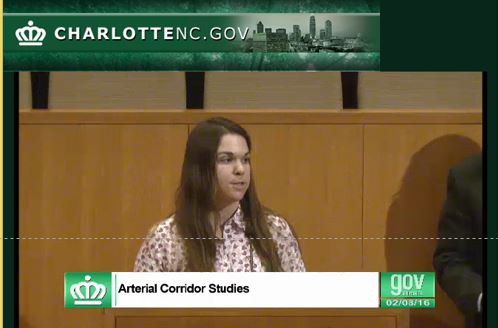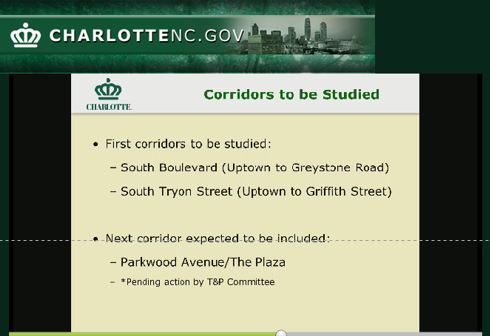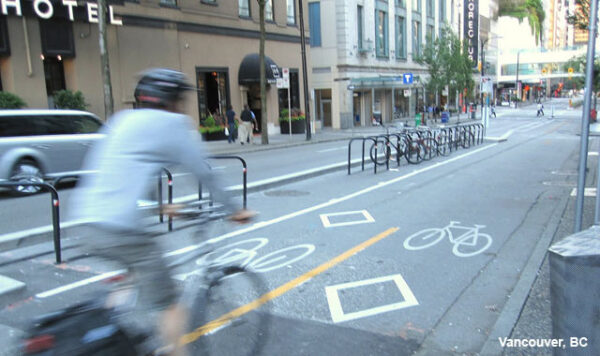Sustain Charlotte applauds city for new bicycle and pedestrian studies
It’s no secret that Charlotte’s transportation network is primarily built for cars, not for people on bikes or on foot. But that’s been changing in recent years as Charlotte Department of Transportation has taken an approach that considers the needs of not only auto drivers, but also those who cannot or choose not drive.
Monday night’s unanimous City Council support for a $250,000 study of at least three major arterials, or high-traffic urban streets, was a big win for the city’s future! The study contract was awarded to Stantec following a competitive Request for Qualifications in November 2015. The contract is funded by $200,000 in federal planning dollars approved by the Charlotte Regional Transportation Planning Organization (CRTPO) and a 20% local match ($50,000) from Charlotte Department of Transportation (CDOT).
Sustain Charlotte’s Education and Outreach Director, Meg Fencil, took the podium to thank Council for their commitment to meeting the transportation needs of all residents by approving this study.

Sustain Charlotte’s Meg Fencil spoke in support of the arterial corridor studies. Click to view (Feb 8 meeting; 01:18)
CDOT’s Norm Steinman explained that the studies will include South Blvd. and South Tryon close to Uptown. These areas have seen a boom in re-development since the LYNX Blue Line light rail opened in 2007. According to Steinman, an economic real estate consultant mentioned that the South Blvd. corridor has experienced perhaps the most extensive amount of re-development along any light rail line in the U.S. We’d call that a pretty amazing return on Charlotte’s investment in transit!
The third corridor to be included in the study has not yet been finalized, but Steinman indicated that it could very well be Parkwood Avenue and The Plaza, pending action by Council’s Transportation and Planning Committee. Following the tragic death of 73 year-old Al Gorman after he was struck by a vehicle while riding his bicycle on Parkwood’s sidewalk, the residents of Villa Heights, Belmont, and Plaza Midwood collected over 600 signatures on a petition to modify this corridor with protected bike lanes, better sidewalks, and a planted median. The residents presented their petition to City Council in November 2015. Click here to see the messages they shared during that meeting.
We share the residents’ excitement that Council and CDOT heard their voice and responded! But the need for safe walking and bicycling routes extends far beyond South End and Parkwood/The Plaza.

Slide shown by Norm Steinman outlining the likely scope of the studies.
At times in the past, we’ve run into opposition from elected officials when we talked about the need to invest in bicycle and pedestrian infrastructure. It’s an idea that most people support in theory, but there’s often hesitation about the cost or political implications.
Monday night was different. The overall message we heard from Council was: How can I get more bicycle and pedestrian infrastructure in my district?
Council member Ed Driggs (District 7) spoke of being knocked off his bike while riding in his district, and wanting to see more investment made there. “This would be a great opportunity for some investment to come to District 7 since I’ve talked in the past about how we don’t see any.”
John Autry (District 5) pointed out that this type of study, followed by on the ground changes to our infrastructure, is needed in East Charlotte and throughout the city. “I would like to remind Council that whenever we said that we wanted to look at Parkwood, that I mentioned Sharon Amity and the conditions we have there at the Castleton junction and how dangerous that has been over the years. I would hope that we would be able to focus on these other areas throughout the city as soon as possible…We’ve looked a lot at South End, but we need infrastructure going east and west also.” Click here to view a safety study that was done at this junction.
We agree with Driggs and Autry that the need for studies and improvements city-wide vastly exceeds the scope of this current contract with Stantec, which will likely examine only three corridors. Evidence is pouring in from other U.S. cities that protected bike lanes can dramatically increase participation in bicycling for recreation and transportation. The need and demand for them is rapidly increasing.

A protected bike lane (cycle track) in Vancouver. Photo: NACTO
These studies aren’t just about protected bike lanes. They’re about determining the locations where sidewalks, crosswalks, crossing signals, bike boxes, and other infrastructure for people on bike or on foot is most needed. According to Steinman, the improvements recommended by the studies will be of two types: short-term, low-cost and medium-term, higher cost. We were most excited to hear that Charlotte will be getting a cycle track, or separated bike lane, sometime in 2016!
Providing safe and accessible transportation routes for all Charlotteans means improving the quality of life for everyone, but especially those who currently have no good transportation choices. Autry said, “There are some folks on the East side, for whom maintaining an automobile is a challenge and the opportunity to have protected bicycle lanes and infrastructure so that people can get to work, so that people can get to the retail and the eating establishments…It would be nice to have that opportunity.”
Vi Lyles (Mayor Pro Tem) said, “It’s a nice problem to have when people are excited about every area of the city having a more pedestrian and bike-friendly environment. At some point, it’s beginning to change the way we look at roads. I hope that this study will address not only what we need to be doing, but as we are building [because] most of our roads are built through the development process.”
“I may be a little reluctant to be in a five-foot lane with a white stripe versus something grade-separated.”, said Lyles. Clair Fallon(At Large) agreed: “It needs those dividers from the road itself.”
Charlotte is in very good company as we ramp up our investment in bicycle and pedestrian infrastructure. Around the nation, National Association of City Transportation Officials (NACTO)’s Urban Bikeway Design Guide is transforming the ways that urban areas, from small towns to large cities, are meeting the needs of people on bikes. Protected bike lanes are the new standard for urban transportation Creating them also benefits the safety of auto drivers, transit riders, and pedestrians! Check out our comments below for just a few of their many benefits.
Just prior to the vote, we address Council for a few minutes. You can watch (Feb. 8; beginning at 01:18) or read below to find out what we said:
Good evening,
My name is Meg Fencil. I’m the Education and Outreach Director for Sustain Charlotte.
I’m here tonight to thank you for making a major investment in the future of our city, and to ask you to continue investing.
The proposed arterial corridor studies will create a clear path for making the best possible investment of our transportation dollars as we transform Charlotte’s high-capacity urban roads to provide safe and accessible transportation choices for people of all ages and abilities. This includes those who choose not to –or cannot–drive a car.
For many decades, we’ve just designed our roads to move as many cars as possible as fast as possible. Thankfully that has finally changed, but we have a lot of catching up to do!
In our rapidly urbanizing area, the sustainable way forward — and the national benchmark– is to re-design roads to not only move vehicles efficiently, but also to serve people on foot and on bikes:
Our city staff has done — and is doing– an incredible amount of work to transform our transportation network.
But we need to do more to build the sidewalks, crosswalks, protected bike lanes, and other improvements that will create a world-class city that’s sustainable for generations to come.
Other cities that have invested in bicycle and pedestrian infrastructure have seen tremendous benefits.
For economic vitality: After the construction of a protected bike lane on 9th Avenue in NYC, local businesses saw a 49 percent increase in retail sales. Charlotteans spend an average of 26% of household income on transportation, much more than the national average of 19%.
For environmental and human health: As EPA standards for ground-level ozone have become more stringent, safe bicycle and pedestrian infrastructure can clear the air by getting people out of their cars.
For social equity: Children from low-income and minority households are more likely to bike or walk to school. Older adults cite personal mobility as a major factor determining whether they can remain in their home as they age.
For safety: When protected bike lanes are installed in New York City, injury crashes for all road users –drivers, pedestrians, and cyclists–typically drop by 40%.
We also ask you to include Parkwood Avenue and The Plaza in these studies. As you heard directly from neighborhood residents several months ago, this area urgently needs a street re-design after a long history of violent and deadly traffic incidents.
These arterial corridor studies are excellent first step.
We also ask you to continue investing effort and funding in moving Charlotte beyond the planning and study of better streets. When it comes time to build the projects recommended by the studies, we need to build!
Thank you.
Thanks for reading!
As a nonprofit, community support is essential for us to keep doing what we do — including providing free articles like this. If you found this article helpful, please consider supporting Sustain Charlotte.
Want to stay in the loop? Subscribe to our weekly newsletter and follow us on Instagram, Facebook, and Twitter.
